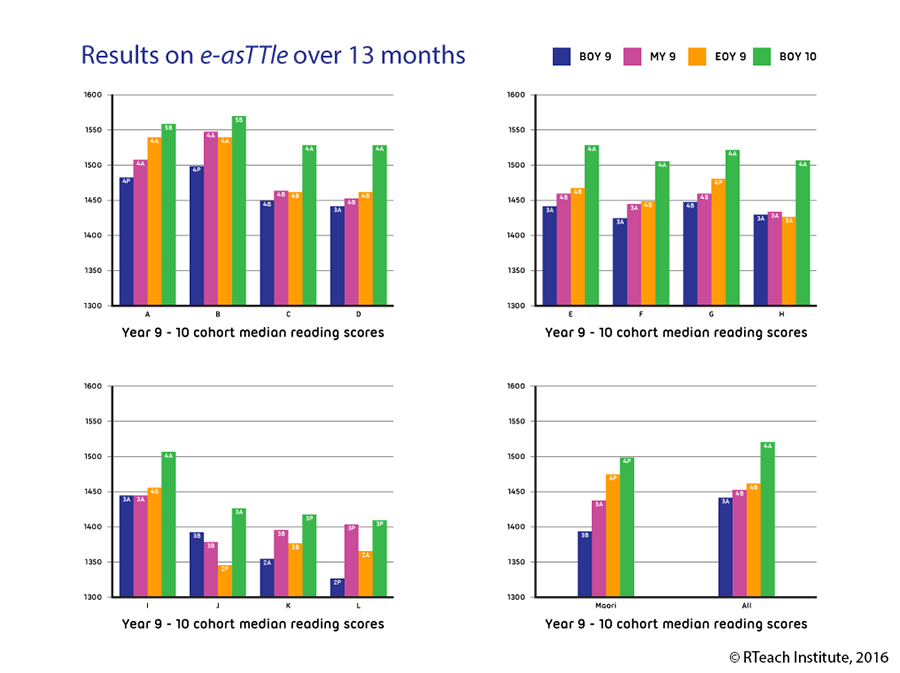Pacific Students Update – April 2019
Implementation research with Reciprocal Teaching – RT3T™ is ongoing in several regions, including Pacific / multicultural urban and Māori small town communities. Schools represent all decile levels, with students from year 3 onwards.
Results have shown significant improvement to raising literacy and numeracy and cross-curricular achievement - for all students, irrespective of age, gender, ethnicity and prior achievement.
In three secondary schools data shows the results are sustained after the Year 9 coaching intensives, with a ‘delayed acceleration leaps’ in NCEA and in scholarship data. For example, a delayed acceleration leap was achieved in 2016 by an entire secondary cohort in one of the large Pacific secondary schools. See the bar graphs below.

These gains were shown in testing completed 8 or more months after the completion of the coaching phase. This result is remarkable because, at outset, this school was typical of many NZ secondary schools, which display an ongoing ‘plateau’ (i.e. minimal or no progress) in longitudinal literacy data throughout the secondary school years. This delayed acceleration leap is consistent with what ‘expert’ teachers in both primary and secondary pioneer schools are saying about the new empowered mindset and deeper learning skills students are showing after a term or two and even after holiday breaks. The delayed acceleration leap also aligns with new international research on collaborative learning - which is relevant because RT is a type of collaborative learning. At the 2015 biennial EARLI conference, Professor Christine Howe1 reported new findings about ‘hugely positive delayed effects’ with collaborative learning.
NCEA data from this secondary school study2 show a sustained shift in achievement levels two years after RT coaching intensives. Carter similarly has shown the value of RT for ongoing cross-curricular use in a school-wide longitudinal study3.
Currently RTeach is providing PLD in 2 Kāhui Ako with predominantly Pacific / multicultural populations.
Transitions. We now have several examples of RT3T™ successfully supporting students with a more seamless transitioning between schools. In our 8th school, a large intermediate with 27 classes (and with over 50% Pacific, and about 20% Māori and 20% Asian students) we are having an enthusiastic uptake by leadership, teachers and students, followed by the buzz of students from this intermediate school settling into an RT3T™ secondary school. When four classes started the intensive coaching in their new high school, we were able to maximise their participation and leadership skills, and students quickly focussed with the thinking and teamwork routines, with teachers reporting that students were leaving class excitedly gesturing and talking the RT3T™ language of working together. The focus now is on late arrivals and students with attendance issues.
‘Cultural sustainability’. Another developing focus is on aligning the collaborative thinking, teaching and learning tools with the new national focus on ‘cultural sustainability’. For example, in our 9th school, we are running with coaching intensives for all year 9 classes in English, and plan both to extend RT3T™ into language classes (i.e. Samoan, Cook Island Māori, Tongan, te reo Māori, and Mandarin), to develop trained students as junior leaders, and to build in perspective-taking further as a core thinking and collaborative skill.
Other key extensions include aligning academic achievement with sports achievement through certificate ceremonies involving students hosting and sharing their new thinking and team expertise with their families; homework centres; holiday programmes; integration into family / church / community groupwork / dialogue.
One teacher reported: “At a student/parent learning conference, I suggested to a Pacific student that she explain to her parents about what we’d been doing in RT3T™. Her mother immediately said there was no need as XXX had told them all about it and was leading the whole family, including younger siblings, in RT3T™ at home with their reading books. This was amazing as this particular student was exceptionally shy in the RT3T™ groups and had to be prompted to participate.”
This rippling out is also extending into homework centres, as well as cultural and community centres, at hubs in which family/whanau from different schools come together and socialise. This was seen when parents/whanau from one South Auckland secondary school wanted to know why RT3T™ wasn’t available at their school, as they had heard such positive comments from their church friends from another school.
[1] Howe, Christine. Dialogue and knowledge transformation: towards a socio-cultural theory of cognitive growth. Keynote at EARLI Conference, Cyprus. Keynote video Christine Howe - Earli 2015
[2] Westera, J., Ritchie, B., Smith, S., Francis, R. & Gasson, C. (2013). Reciprocal Teaching: a No. 1 smart tool to accelerate achievement across the curriculum for all students. Presentation to MoE, Wellington, June.
[3] See Educational Leadership, 54 (6). Why Reciprocal Teaching? - ASCD.
Tags:
high school
RT3T
Pacific
reciprocal teaching
graphs
multicultural
primary school
literacy
secondary school
NCEA
evidence base
reading
thinking skills
teamwork
leadership
reciprocal reading
inclusion
cross-curricular
pedagogy
key competencies
communication skills
accelerated learning
language learning
2019
oral language
